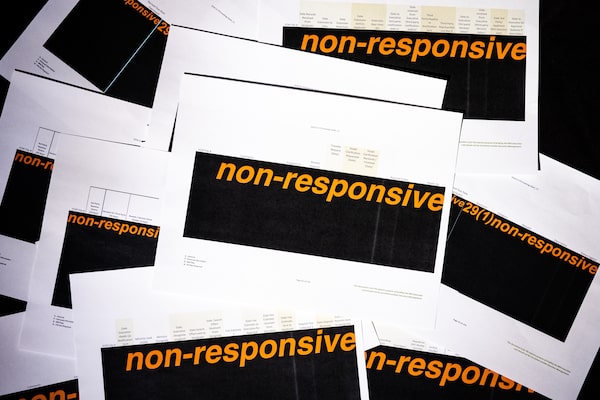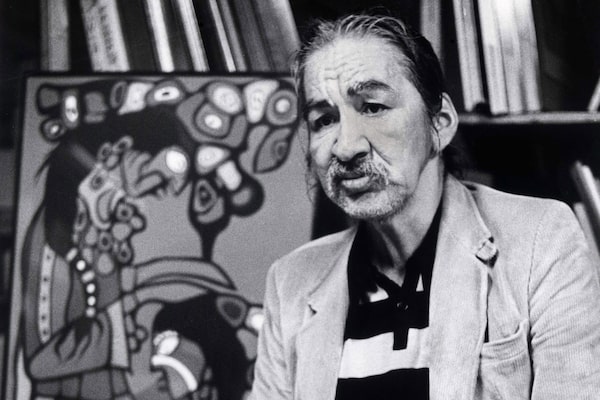Good morning, and welcome to the weekend.
Grab your cup of coffee or tea, and sit down with a selection of this week’s great reads from The Globe. In this issue, reporters Robyn Doolittle and Tom Cardoso do a deep dive into Canada’s broken freedom-of-information regime. What started as an afternoon chat among two colleagues sharing their frustrations over the country’s dysfunctional access system, eventually grew into a massive project that would see Robyn and Tom interview more than 200 experts and file more than 500 FOI requests to every level of government to understand how the system works – or doesn’t.
Their exhaustive 20-month-long investigation – called Secret Canada – found that FOI units across the country are starved of resources and staff, the access laws are outdated and not designed for the digital world, and public servants are regularly advised by their superiors to withhold information – facing few to no consequences for breaking the laws.
The Globe’s Secret Canada project aims to make governments more transparent. The result is a database of more than 300,000 FOI request summaries spanning more than 600 government and public institutions across the country.
“We hope Secret Canada will spark for others the same passion for transparency and accountability that drives us,” Robyn wrote in a piece that accompanies the main story on the investigation.
If you’re reading this on the web, or it was forwarded to you from someone else, you can sign up for Great Reads and more than 20 other Globe newsletters on our newsletter sign-up page. If you have questions or feedback, drop us a line at greatreads@globeandmail.com.
Inside Canada’s broken freedom-of-information system: ‘An affront to democracy’

A heavily-redacted list of freedom-of-information requests from Saskatchewan’s Ministry of Highways.Melissa Tait/The Globe and Mail
Information held by the government is supposed to be yours. But at every turn, the process to obtain that information gives institutions incentives to keep records hidden. The result is that the access-to-information system is so broken and backlogged that the government is actively ignoring its own legislation. A Globe investigation by Robyn Doolittle and Tom Cardoso – which included 253 individual freedom-of-information requests with every government department and ministry in the country – found that institutions are regularly withholding information that courts have repeatedly declared is public, such as contracts, for reasons as simple as the fact that the requested information could be deemed embarrassing.
Read more:
- Explore the Secret Canada website: Search our database of hundreds of thousands of FOI request summaries filed across the country, and read about how to file requests, navigate the system and appeal decisions.
- Editor-in-Chief David Walmsley: Our freedom-of-information systems, binding frameworks to ensure Canadians have transparency, have collapsed under their own weight.
- Behind the story: How a conversation between two reporters in the fall of 2021 spawned a newsroom-wide project.
- Podcast: Robyn Doolittle and Tom Cardoso speak with Decibel host Menaka Raman-Wilms about their 20-month-long investigation into the state of Canada’s FOI system.
From CERB to child benefits, Ottawa’s debt collections are clobbering the poor for small mistakes

Photo illustration by the globe and mail/iStockPhoto / Getty Images
The Trudeau government’s message to Canadians in the earlier days of the COVID-19 pandemic was clear and reassuring: “we have your back.” But with the crisis now largely over, the zeitgeist has changed and Ottawa wants some of its money back. As Erica Alini reports, in trying to recoup the overpayments, the Trudeau government and the CRA seem to have given little consideration to the fact that the pandemic benefits were hastily designed and their rollout messy, with changes and errors in the government’s own communication about eligibility criteria.
Inside Saadi Gadhafi’s secret plan to sell his luxury Toronto penthouse

A condominium at 10 Navy Wharf Court in downtown Toronto, is photographed on June 8, 2023. The penthouse condo, owned by Saadi Gadhafi is under a UN asset freeze as well as sanctions by Canada.Fred Lum/The Globe and Mail
How effective are Canada’s sanctions? The answer to that question remains to be seen for Saadi Gadhafi, the third-born son of former Libyan dictator Moammar Gadhafi who was embroiled in the SNC-Lavalin bribery scandal. Saadi is considering selling his luxury penthouse in Toronto – despite it being subject to a UN asset freeze. Rita Trichur reports on how Canada’s reputation for weak enforcement of international sanctions emboldens bad actors operating at home and abroad.

Charlotte Gill and her twin brother came to Canada in 1971 with their parents, a white British mother and an Indian father. She shares their experience in a new memoir.Supplied
Today, Canada is almost one-quarter immigrants. More than a million people of South Asian descent live in the Greater Toronto Area alone. But in 1971, when immigration reform was virtually brand new, fewer than 70,000 South Asians lived all across Canada. Back then, writes Charlotte Gill, it wasn’t so easy to be a dark-skinned foreigner with a heavy accent, to be an Indian without a Little India. In her own words, Gill writes about her biracial identity, and how her parents’ romance radically changed the course of their lives and reshaped their family tree.
Kaden Pitcher, a transitioning teen, sits for his portrait in his home in Breslau, Ont.Alicia Wynter|www.aliciawynter.c/The Globe and Mail
After the York Catholic District School Board voted against raising the Pride flag this month, many of its students were crushed. A day later, Toronto Blue Jays pitcher Anthony Bass apologized for sharing an anti-LGBTQ2S+ Instagram post. The examples are the latest in a string of increasing anti-LGBTQ2S+ incidents in Canada, such as protests at drag queen story hours in libraries. Teenagers, who are frequently at the centre of anti-LGBTQ2S+ hate, and activists say more education and more forceful activism is needed to assert their rights and ensure their safety. The Globe speaks to them to get a picture of life in an increasingly hateful world.
Democracy isn’t dying. It was never really alive

Storm clouds pass by the Peace Tower and Parliament Hill, Aug. 18, 2020 in Ottawa.Adrian Wyld/The Canadian Press
As the 21st century has gathered pace, so has the rise of right-wing populism. This is true in India, the United States, Britain, Hungary, Brazil and elsewhere, which have experienced some of its worst effects, under different names but in the same spirit: Narendra Modi’s Hindutva, Donald Trump’s MAGA, Boris Johnson’s Brexit, Jair Bolsonaro’s Brasil Primeiro. From a cursory glance, it would appear that democracy is dying. But A.C. Grayling argues that our sustained, centuries-old campaigns to elevate vested interests in our politics has meant that democracy has never truly existed, and has never really stood a chance.
Inside the strange legal sideshow that helped fuel the Norval Morrisseau art forgery scandal

Indigenous artist Norval Morrisseau says he is happy sketching in the streets of Vancouver as he poses in front of one of his earlier paintings at a Vancouver gallery on May 11, 1987.Chuck Stoody/The Canadian Press
In March, investigators with the Thunder Bay Police and Ontario Provincial Police arrested eight people for allegedly counterfeiting between 4,500 and 6,000 pieces of art credited to Norval Morrisseau, an Indigenous artist who died in 2007. With an average Morrisseau going for $15,000, the value of alleged forgeries could approach $100-million, police said. But as Patrick White reports, the story that shone a spotlight on these forgeries centres around elderly couple John and Joan Goldi, who were held in contempt of court and had declared themselves defenders of Morrisseau’s legacy, attacking anyone who dared to speak out about fake paintings.
On her 100th birthday, artist Françoise Sullivan still has work to do
Artist Françoise Sullivan in front of her artwork at Galerie de l'UQAM in Montreal on May 10, 2023.Stephanie Foden/The Globe and Mail
Throughout her 80-year career, Montreal artist Françoise Sullivan has lived through multiple artistic movements and reinvented her practice several times. Today, she is both a piece of living history – as one of the last surviving members of the Automatistes group of artists who revolutionized Quebec culture in the 1940s – and a practising contemporary artist. To celebrate her 100th birthday, Sullivan will exhibit new pieces at the Université du Québec à Montréal that will focus on her career in the 1970s, marking her time in Italy and the beginnings of her experimentation with conceptual art.
Drawn from the headlines
Emboldened shoppers threaten Target workers over Pride Month items. Washington Post, June 4, 2023 as drawn by Sami Alwani for The Globe and Mail
